Foods That Fight Pain
Foods That Fight Pain
 Pain is something just about everyone of us has experienced at one time or another. But just what is behind it? Pain is mostly a sign that something somewhere in your body is not right. Medication prescribed by our doctors is one of the most common ways to fight pain and help us lead our lives in a somewhat more comfortable way. This I guess is dependent on the level and frequency of the pain.
Pain is something just about everyone of us has experienced at one time or another. But just what is behind it? Pain is mostly a sign that something somewhere in your body is not right. Medication prescribed by our doctors is one of the most common ways to fight pain and help us lead our lives in a somewhat more comfortable way. This I guess is dependent on the level and frequency of the pain.
In most cases, the pain is caused by inflammation. A few examples of conditions caused by excessive inflammation include arthritis, type 2 diabetes and fibromyalgia. There have been some cases of individuals getting addicted to pain killers. Because of this and many other reasons including perhaps individuals just wanting to eat healthy, more and more people are looking for natural ways to deal with the discomfort and pain.
So in addition to the medicine and physical therapy, there are also foods that may be used to fight pain. However, it is of utmost importance that one consults their doctor before treating any pain with food. There are some foods that actually increase inflammation and ultimately pain and some foods reduce it. This article will mostly focus on the foods that fight pain and just give a list of foods that one especially needs to avoid when in pain. Did you know that the nutrients that your body receives especially when you eat right can work against pain in four different ways? First, they can reduce damage at the site of injury, then cool your body's inflammatory response, provide analgesia on the pain nerves themselves, and even work within the brain to reduce pain sensitivity. Now that's something! If you look at it closely, foods that fight pain are almost all around us. It's just that we don't know them.
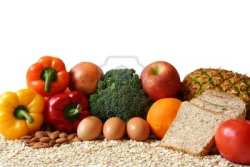 Whole grains, fruits, vegetables and foods rich in Omega-3-fatty-acids have been found to be helpful in fighting against pain. They do this by reducing or preventing inflammation. Whole grains are foods that have not been over-processed to the extent that most of the nutrition from the grain has been lost in the process.
Whole grains, fruits, vegetables and foods rich in Omega-3-fatty-acids have been found to be helpful in fighting against pain. They do this by reducing or preventing inflammation. Whole grains are foods that have not been over-processed to the extent that most of the nutrition from the grain has been lost in the process.
As we mentioned earlier, nutrients can work against pain. Whole grains in particular have the ability in them to reduce the levels of a C-reactive protein which when is present in the body is an indicator of inflammation. When it is present in high levels it has been associated with hypertension, heart disease and diabetes.
So there definitely is a greater benefit in eating whole foods that just enjoying the taste!You may even consider embarking on a whole foods diet. Not only do they deal with pain but they also help one to lose weight and after that, maintain a healthy weight. Examples of whole grains include whole wheat bread, cereals made from whole grain such as bran and oats, brown rice, etc. It's important that you look at the ingredients panel of the foods you pick so as to see if the product has been made from whole grain.
When it comes to fruits and vegetables it has somewhat been apparent over the ages how important they are and what benefits our bodies gain from eating them, yet we still don't consume enough! Fruit nutrition and vegetable nutrition facts give us more insight on just how much our bodies can gain from eating them. Just about all fruits and vegetables are loaded with antioxidants, vitamins, minerals and nutrients. For this reason they qualify to be in the foods that fight pain list. These mineral, nutrients, vitamins and antioxidants are essential, amongst other things for fighting against free radicals. One of the things that free radicals do is cause damage to cells in the body which in the process may bring about pain or highly compromise your immune system.
And speaking of the immune system, fruits and vegetables are great boosters for your immune system, helping it to fight against infections that may attack your body. It is of utmost importance that you have a variety of fruits and vegetables in order to gain high levels of antioxidants as well as nutritional benefits. Fruits and vegetables such as oranges, kiwi, peaches, cherries, cranberries and cauliflower are known for their potential to relieve pain. When you suffer from pain caused by constipation, fiber-rich fruits and vegetables such as avocados, apples, bananas, sweet potatoes and raisins just to name a few may help to ease that pain. Shiitake mushrooms are also known for their ability to boost your immune system.
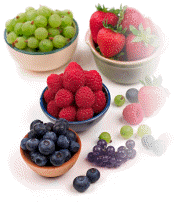 Strawberries, cranberries, blackberries, blueberries and sweet cherries contain high levels of antioxidant compounds. These compounds protect joints, tendons and cartilage and are very helpful in fighting gout, arthritis and fibromyalgia, hence they are found amongst the foods that fight pain. Cherries also reduce muscle pain and strain. Pineapples and Papaya contain bromelain and papain which are protein digesting enzymes. These two enzymes have anti-inflammatory properties, hence prevent pain. Broccoli helps in eye inflammation. It is also packed with Vitamin C and Calcium which help to boost the immune system.
Strawberries, cranberries, blackberries, blueberries and sweet cherries contain high levels of antioxidant compounds. These compounds protect joints, tendons and cartilage and are very helpful in fighting gout, arthritis and fibromyalgia, hence they are found amongst the foods that fight pain. Cherries also reduce muscle pain and strain. Pineapples and Papaya contain bromelain and papain which are protein digesting enzymes. These two enzymes have anti-inflammatory properties, hence prevent pain. Broccoli helps in eye inflammation. It is also packed with Vitamin C and Calcium which help to boost the immune system.
However, if you also suffer from irritable bowel syndrome (IBS) it may be helpful to first cook your fruits and vegetables before you consume them. You may also want to check out the diet for IBS to help you cope. As we mentioned earlier, foods that are high in Omega-3-fatty acids are amongst the foods that fight pain. This is because they have the ability in them to control inflammation. They are especially helpful with low back pain and arthritis. Some examples of food sources of omega-3-fatty acids include salmon, tuna, walnuts, mackerel and flax-seeds (ground flax-seeds are the best for maximum absorption).
Research by some dieticians has revealed that high-fat foods (whole milk, red meat, etc) can exacerbate inflammation. So it is advised to stick to a low-fat diet and replacing high-fat food with things like legumes which are high sources of protein, as well as providing your body with nutrients such as B-vitamins, Iron, Zinc and Fiber.
Foods That Fight Pain: Back
Usually, back pain is caused by pinched nerves, muscle strains, injuries, and osteoporosis. We stated earlier on that foods rich in Omega-3-fatty acids are very helpful when it comes to easing low back pain. A few examples of these foods include mackerel, tuna, cold water fish, salmon, herring, canola oil, dried butternut, soybeans, dried beechnuts.
Foods That Fight Pain: Arthritis and Joint
Arthritis occurs when one or more of your joints are inflamed resulting in pain, stiffness and swelling, even limited movement for some. There are also foods that can either ease the pain, reduce the inflammation or both. So which are these foods that fight pain caused by arthritis?
- Foods high in Selenium such as salmon, eggs, brown rice, oatmeal, beef and turkey amongst others
- Foods high in antioxidants e.g. fruits and vegetables including spinach, oranges, berries, kale, strawberries, cranberries, blackberries, blueberries and sweet cherries etc. Antioxidants help to prevent or reduce swelling, pain and stiffness.
- Celery, mustard, garlic, ginger, pickles, onions and parsley are also known to reduce inflammation in the body.
- Lean protein sources (poultry, tofu, fish, etc) are especially advised for arthritis sufferers. This is because they contain less saturated fat as well as help you to maintain a healthy weight. This, (maintaining a healthy weight) is especially important when you have arthritis so you avoid adding more stress and pressure to joints that bear weight. When more stress is added to these joints it could worsen the symptoms of arthritis.
Foods That Fight Pain: Fibromyalgia
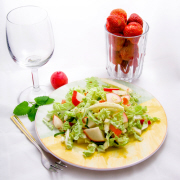 Fibromyalgia is a condition that is chronic that is more common in women than in men. It causes pain, mental fatigue and fatigue in the muscles, tendons and ligaments in the body. It is often associated with health issues such as IBS and depression. A raw food diet as well as a diet rich in protein and omega-3-fatty acids can help to alleviate the pain and discomfort you feel when one suffers from fibromyalgia.
Fibromyalgia is a condition that is chronic that is more common in women than in men. It causes pain, mental fatigue and fatigue in the muscles, tendons and ligaments in the body. It is often associated with health issues such as IBS and depression. A raw food diet as well as a diet rich in protein and omega-3-fatty acids can help to alleviate the pain and discomfort you feel when one suffers from fibromyalgia.
Protein has been found to be helpful in offsetting chronic fatigue which is one of the most common symptoms of this condition. It also helps to keep your blood sugar levels balanced when you incorporate it in your meals in small amounts throughout the day.
On that note, it's important to reduce the amount of carbohydrates that you consume as they can easily cause your blood sugar levels to spike rapidly. When blood sugar levels spike, they promote inflammations. Protein also relieves the pain and stiffness found in the joints of those who suffer from fibromyalgia. Good sources of protein include beans, lean meats, low-fat dairy products, tofu, seafood and soy amongst many others. Once again, foods that are high in antioxidants can also alleviate fibromyalgia pain.
As discussed earlier, one of the best sources of these are fruits and vegetables. A few examples of what you can eat include bell pepper, tomatoes, spinach, blueberries, kale, strawberries, cranberries, blackberries, and cherries. Studies have shown that individuals who have changed their diets and incorporated these in addition to a low-sodium diet have experienced great relief from fibromyalgia pain.
Foods That Fight Pain List
Here below is a list of foods that fight pain that we have discussed in this article;
- Fruits and Vegetables: Cherries and Berries (strawberries, blueberries, cranberries, blackberries, raspberries and sweet cherries), Pineapple, Papaya, Avocados, Bananas, Oranges, etc) Just eat a wide variety of fruits and vegetables.
- Vegetable oils: Olive Oil, Sunflower Oil, Safflower Oil
- Spices and Herbs such as Tumeric, Garlic, Ginger, Parsley and Curry Powder
- Walnuts and all types of nuts, Hemp seeds, Flaxseeds and Sesame Oil
- Whole grain foods: quinoa, buckwheat, wild and brown rice, etc
- Whole soy food: soy milk, tofu, tempheh, soy nuts, etc
- Seafood and fish: salmon, herring, tuna, mackerel, black cod, sardines
- Beans and Chickpeas, lentils and black-eyed peas.
- Green tea, white tea and oolong tea (high in antioxidant compounds which lower inflammation) and finally, for those with a sweet tooth;
- Dark chocolate, fruit sorbets and unsweetened dried fruit.
Foods That Fight Pain Recipes
Here are some dessert recipes you can make using some of the ingredients/ foods that we have discussed in this article. They are adapted from Foods That Fight Pain by Neal Barnard, M.D. and the recipes are by Jennifer Raymond.
Berry Applesauce
This recipe makes 2 cups and you may serve this applesauce hot or cold.
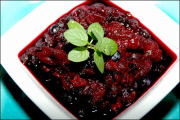
Ingredients
- 2 cups peeled, cored, and chopped apples
- 2 cups strawberries, blueberries, or raspberries, fresh or frozen (unsweetened)
- 1/2 cup frozen apple juice concentrate
- cinnamon
Directions
In a medium-sized saucepan combine all ingredients. Bring to a simmer, then cover and cook over very low heat for about 25 minutes, or until apples are tender when pierced with a fork. Mash lightly or purée in a food processor, if desired. Sprinkle with cinnamon to serve.
Yam Spiced Muffins
This recipe makes 10 to 12 muffins.
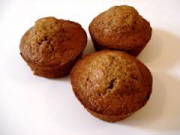
Ingredients
- 2 cups whole-wheat flour or whole wheat pastry flour
- 1/2 cup sugar
- 1 tablespoon baking powder
- 1/2 teaspoon baking soda
- 1/2 teaspoon salt
- 1/2 teaspoon cinnamon
- 1/4 teaspoon nutmeg
- 1 1/2 cups cooked, mashed yams
- 1/2 cup water
- 1/2 cup raisins
- Preheat the oven to 375°F.
- In a large bowl mix whole wheat flour, sugar, baking powder, baking soda, salt, cinnamon, and nutmeg.
- Add yams, the water, and raisins; stir until just mixed.
- Lightly coat a muffin pan with vegetable oil spray. Fill cups to the top with batter. Bake for 25 to 30 minutes, or until the top of a muffin bounces back when pressed lightly.
- Let stand for 1 to 2 minutes before removing from the pan. When cool, store in an airtight container.
Foods To Avoid
When in pain, try and avoid eating foods;
- made with trans fats,
- that are processed,
- high in saturated fat,
- high in fructose corn syrup.


